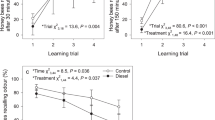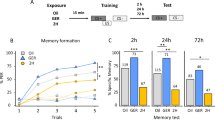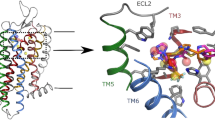Abstract
Exposing honey bees to isopentylacetate (IPA) can cause stress-related changes in learning performance. In bees of foraging age, IPA’s effects on learning are mimicked by C-type allatostatins (AstCC, AstCCC) injected into the brain. Here we ask whether allatostatins induce a similar response in young (6-day-old) bees and if so, whether their effects on learning performance are modulated by queen mandibular pheromone (QMP). We found that young bees exposed to IPA responded less to the conditioned stimulus during training than controls (Type 1-like stress response). AstCC treatment induced a similar response, but only in bees maintained without QMP. Bees exposed to QMP responded to AstCC with increased odour responsiveness and odour generalisation in the 1-h memory test (Type 2-like response). Type 2-like responses could be induced also by the A-type allatostatin, AstA. However, in bees exposed to QMP, AstA-induced odour generalisation was absent. Effects of AstCCC treatment in young bees were weak, indicating that responsiveness to this peptide changes with age. Our findings are consistent with the hypothesis that honey bee allatostatins play a role in stress reactivity, but suggest in addition that allatostatin signalling is age dependent and susceptible to modulation by pheromone released by the queen bee.



Similar content being viewed by others
Abbreviations
- AstA:
-
Allatostatin A
- AstC:
-
Allatostatin C
- AstCC:
-
Allatostatin CC
- AstCCC:
-
Allatostatin CCC
- GLMM:
-
Generalised linear mixed effects modelling
- IPA:
-
Isopentylacetate
- PER:
-
Proboscis extension response
- QMP:
-
Queen mandibular pheromone
References
Amdam G (2011) Social context, stress and plasticity of aging. Aging Cell 19:18–27
Audsley N, Weaver RJ (2006) Analysis of peptides in the brain and corpora cardiaca-corpora allata of the honey bee, Apis mellifera using MALDI-TOF mass spectrometry. Peptides 27:512–520
Baayen RH, Davidson DJ, Bates DM (2008) Mixed-effects modeling with crossed random effects for subjects and items. J Mem Lang 59:390–412
Balderrama N, Núñez J, Guerrieri F, Giurfa M (2002) Different functions of two alarm substances in the honeybee. J Comp Physiol A 188:485–491
Bitterman ME, Menzel R, Fietz A, Schäfer S (1983) Classical conditioning of proboscis extension in honeybees (Apis mellifera). J Comp Psychol 97:107–119
Boerjan B, Cardoen D, Bogaerts A, Landuyt B, Schoofs L, Verleyen P (2010) Mass spectrometric profiling of (neuro)-peptides in the worker honeybee, Apis mellifera. Neuropharmacol 58:248–258
Collins AM, Blum MS (1983) Alarm responses caused by newly identified compounds derived from the honeybee sting. J Chem Ecol 9:57–65
Decourtye A, Armengaud C, Renou M, Devillers J, Cluzeau S et al (2004a) Imidacloprid impairs memory and brain metabolism in the honeybee (Apis mellifera L.). Pestic Biochem Physiol 78:83–92
Decourtye A, Devillers J, Cluzeau S, Charreton M, Pham-Delègue M-H (2004b) Effects of imidacloprid and deltamethrin on associative learning in honeybees under semi-field and laboratory conditions. Ecotoxicol Environ Saf 57:410–419
Free JB, Simpson J (1968) The alerting pheromones of the honeybee. Z vergl Physiol 61:361–365
Geddes LH, McQuillan HJ, Aiken A, Vergoz V, Mercer AR (2013) Steroid hormone (20-hydroxyecdysone) modulates the acquisition of aversive olfactory memories in pollen forager honeybees. Learn Mem 20:399–409
Gospocic J, Shields EJ, Glastad KM, Lin Y, Penick CA, Yan H, Mikheyev AS, Linksvayer TA, Garcia BA, Berger SL, Liebig J, Reinberg D, Bonasio R (2017) The neuropeptide corazonin controls social behavior and caste identity in ants. Cell 170:748–759.e12
Gruntenko NE, Rauschenbach IY (2018) The role of insulin signalling in the endocrine stress response in Drosophila melanogaster: a mini review. Gen Comp Endocrinol 258:134–139
Guerrieri F, Schubert M, Sandoz J-CC, Giurfa M (2005) Perceptual and neural olfactory similarity in honeybees. PLoS Biol 3:e60
Jaeger T (2008) Categorical data analysis: away from ANOVAs (transformation or not) and towards logit mixed models. J Mem Lang 59:434–446
Jarriault D, Mercer AR (2012) Queen mandibular pheromone; how does it work? Apidologie https://doi.org/10.1007/s13592-011-0117-6
Jassim O, Huang Z, Robinson G (2000) Juvenile hormone profiles of worker honey bees, Apis mellifera, during normal and accelerated behavioural development. J Insect Physiol 46:243–249
Kaatz H-H, Hildebrandt H, Engels W (1992) Primer effect of queen pheromone on juvenile hormone biosynthesis in adult worker honey bees. J Comp Physiol B 162:588–592
Núñez J, Almeida L, Balderrama N, Giurfa M (1998) Alarm pheromone induces stress analgesia via an opioid system in the honeybee. Physiol Behav 63:75–80
Pratavieira M, da Silva Menegasso AR, Garcia AM, Dos Santos DS, Gomes PC, Malaspina O, Palma MS (2014) MALDI imaging analysis of neuropeptides in the Africanized honeybee (Apis mellifera) brain: effect of ontogeny. J Proteome Res 13:3054–3064
Robinson G (1987) Modulation of alarm pheromone perception in the honey bee: evidence for division of labor based on hormonally regulated response thresholds. J Comp Physiol 160:613–619
Robinson GE, Winston ML, Huang Z-Y, Pankiw T (1998) Queen mandibular gland pheromone influences worker honey bee (Apis mellifera L.) foraging ontogeny and juvenile hormone titers. J Insect Physiol 44:685–692
Romero LM, Platts SH, Schoech SJ, Wada H, Crespi E, Martin LB, Buck CL (2015) Understanding stress in the healthy animal—potential paths for progress. Stress 18:491–497
Rutz W, Gerig L, Wille H, Lüscher M (1976) The function of juvenile hormone in adult worker honeybees, Apis mellifera. J Insect Physiol 22:1485–1491
Sakagami S (1954) Occurrence of an aggressive behaviour in queenless hives, with considerations on the social organization of honeybee. Insect Soc 1:331–343
Schmitt F, Venselow JT, Schlosser A, Wegener C, Rossler W (2017) Neuropeptides in the desert ant Cataglyphis fortis: mass spectrometric analysis, localization and age-related changes. J Comp Neurol 525:901–918
Slessor KN, Winston ML, Le Conte Y (2005) Pheromone communication in the honeybee (Apis mellifera L.). J Chem Ecol 31:2731–2745
Stay B, Tobe SS (2007) The role of allatostatins in juvenile hormone synthesis in insects and crustaceans. Annu Rev Entomol 52:277–299
Sullivan JP, Fahrbach SE, Robinson GE (2000) Juvenile hormone paces behavioral development in the adult worker honey bee. Horm Behav 37:1–14
Sullivan JP, Fahrbach SE, Harrison JF, Capaldi EA, Fewell JH, Robinson GE (2003) Juvenile hormone and division of labor in honey bee colonies: effects of allatectomy on flight behavior and metabolism. J Exp Biol 206:2287–2296
Takeda K (1961) Classical conditioned response in the honey bee. J Insect Physiol 6:168–179
Trawinski AM, Fahrbach SE (2018) Queen mandibular pheromone modulates hemolymph ecdysteroid titres in adult Apis mellifera workers. Apidologie. https://doi.org/10.1007/s13592-018-0562-6
Urlacher E, Francés B, Giurfa M, Devaud J-M (2010) An alarm pheromone modulates appetitive olfactory learning in the honeybee (Apis mellifera). Front Behav Neurosci 4:e157
Urlacher E, Tarr IS, Mercer AR (2014) Social modulation of stress reactivity and learning in young worker honey bees. PLoS One 9:e113630
Urlacher E, Soustelle L, Parmentier M-L, Verlinden H, Gherardi M-J, Fourmy D, Mercer AR, Devaud J-M, Massou I (2016a) Honey bee allatostatins target galanin/somatostatin-like receptors and modulate learning: a conserved function? PLoS One 11:e0146248
Urlacher E, Monchanin C, Rivière C, Richard F-J, Lombardi C, Michelsen-Heath S, Hageman KJ, Mercer AR (2016b) Measurements of chlorpyrifos levels in forager bees and comparison with levels that disrupt honey bee learning behavior under laboratory conditions. J Chem Ecol 42:127–138. https://doi.org/10.1007/s10886-016-0672-4
Urlacher E, Devaud J-M, Mercer AR (2017) C-type allatostatins mimic stress-related effects of alarm pheromone on honey bee learning and memory recall. PLoS One 12(3):e0174321. https://doi.org/10.1371/journal.pone.0174321
Veenstra JA (2009) Allatostatin C and its paralog allatostatin double C: the arthropod somatostatins. Insect Biochem Mol Biol 39:161–170
Veenstra JA (2016) Allatostatins C, double C and triple C, the result of a local gene triplication in an ancestral arthropod. Gen Comp Endocrin 230–231:153–157
Vergoz V, Schreurs HA, Mercer AR (2007) Queen pheromone blocks aversive learning in young worker bees. Science 317:384–386
Vergoz V, McQuillan HJ, Geddes LH, Pullar K, Nicholson BJ, Paulin MG, Mercer AR (2009) Peripheral modulation of worker bee responses to queen mandibular pheromone. Proc Natl Acad Sci USA 106:20930–20935
Wang Z, Qu Y, Dong S, Wen P, Li J, Tan K, Menzel R (2016) Honey bees modulate their olfactory learning in the presence of hornet predators and alarm component. PLoS One 11:e0150399
Weick J, Thorn R (2002) Effects of acute sublethal exposure to couma- phos or diazinon on acquisition and discrimination of odor stimuli in the honey bee (Hymenoptera: Apidae). J Econ Entomol 95:227–236
Williamson SM, Wright GA (2013) Exposure to multiple cholinergic pesticides impairs olfactory learning and memory in honeybees. J Exp Biol 216:1799–1807
Yamagata Y, Hiroi M, Kondo S, Abe A, Tanimoto H (2016) Suppression of dopamine neurons mediates reward. PLoS Biol 14(12):e1002586. https://doi.org/10.1371/journal.pbio.1002586
Author information
Authors and Affiliations
Corresponding author
Rights and permissions
About this article
Cite this article
Urlacher, E., Devaud, JM. & Mercer, A.R. Changes in responsiveness to allatostatin treatment accompany shifts in stress reactivity in young worker honey bees. J Comp Physiol A 205, 51–59 (2019). https://doi.org/10.1007/s00359-018-1302-0
Received:
Revised:
Accepted:
Published:
Issue Date:
DOI: https://doi.org/10.1007/s00359-018-1302-0




